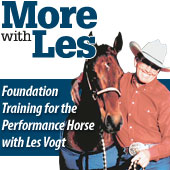
29th in a series
Last issue, Les drilled down in detail lessons on achieving vertical flexion. Softness in the neck is key. Here’s a look.
Again, the first place that resistance is going to show up is in your horse’s neck. You’re going to ask him to do something, and rather than softly responding he’s going to stiffen his neck and brace against your hand. You simply have got to train yourself to not let this happen. You have to insist that he be soft in the poll at all times.
Why will a horse resist? Because he doesn’t like what you’re doing or he doesn’t like what you want him to do. Where did he get these opinions?
First, he could be bracing because at some point you were too quick or harsh with your hands. You want to always to use light pressure, and then lightly bump if you get resistance, giving the horse slack as soon as he yields.
You could also be riding with no feeling in your hands and using so much steady contact that he is learning to lean on your hands. If this is the case, he should respond pretty quickly once you put some life back into your hands. You may have to be a little assertive at first, but he should respond and lighten up quickly so you can too.
A third reason for the bracing is that he has other ideas about what he wants to do right now, and to correct that you just need to get a little more assertive. Just remember the two keys: always start your hand movement lightly and then get stronger if you need to, and always keep your hands active, that is, lightly bumping the bit rather than taking hold and pulling.
Another thing is to make sure he isn’t having a problem with his teeth. Horses that have problems often try to take control of the bit so that they can control the contact and protect themselves. It’s really critical with this type of riding that your horse’s teeth are in good shape, with no sharp edges to cause him discomfort when you pick up a rein.
And finally, to greater or lesser degrees, horses may just be stiff or uncomfortable on one side or the other. They usually overcome this, but if the problem really persists, you can call in the help of your vet or a horse chiropractor. It’s hard to blame them if they are hurting.
Going back to lateral work is always a great way to break down resistance. Practice either lateral flexion or the number two shoulder exercise, which you’ll learn next issue!
Both allow you to work on the horse’s neck and get the resistance out of it. Bringing your horse along slowly and patiently will pay off handsomely if you can keep him happy and confident about the training process. A soft neck is the first indicator of a horse that is enjoying his work.
EDITOR’S NOTE: More with Les is a regular California Horsetrader column. Les Vogt has won more than 15 World Championships, including two wins at the NRCHA Snaffle Bit Futurity. Although Les still rides and occasionally shows, his focus is giving clinics around the world and developing products for the performance horseman. To learn more about Les and to see his clinic schedule, visit: www.lesvogt.com
Leave a Comment
All fields must be filled in to leave a message.